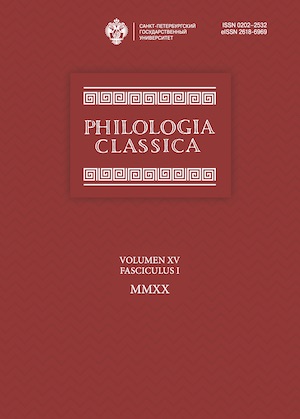‘Phoenissae’, ‘Phoenissa’, ‘Thebais’: The Title of Seneca’s Phoenician Women
DOI:
https://doi.org/10.21638/spbu20.2020.107Аннотация
This paper aims to revise the status quaestionis of the title of a play by Seneca preserved in two commonly recognised variants — Phoenissae and Thebais — and two less well-known variants — Phoenissa and Antigona. It has been generally accepted that only the title Phoenissae is correct, and that this title was modelled on Euripides’ drama of the name. This view, however, can hardly be deemed plausible, considering the substantial differences between Seneca’s and Euripides’ Phoenissae. Moreover, it has been widely held that there is no analogy for the title Thebais in the dramatic tradition but that it has equivalents in epic texts, which has led to the conclusion that Thebais is an ill-chosen interpolation. The other variants of the title have not been discussed at all. In this article we scrutinise previously disregarded sources and argue that all the play’s titles may have originated in Classical Antiquity and may be regarded as synonyms. We also demonstrate that the interpretation of the title Phoenissae as referring to a Chorus of Tyrian maidens is purely speculative, since the links between Seneca’s and Euripides’ Phoenissae cannot be unequivocally defined. We posit that the Romans may have understood both the title of Euripides’ play and of its probable imitation written by Accius as alluding to the heroines, Jocasta and Antigone. The examples found in Statius’ verse may be used as evidence that the adjective Phoenissus was understood by the educated Roman public as Thebanus. In the final part of the paper, we analyse the dramatic action of Phoenissae, which leads us to the conclusion that the interpretation of the title as a metonymic term describing Jocasta and Antigone is accurate.
Ключевые слова:
Seneca the Younger, Phoenissae, Thebais, Roman tragedy
Скачивания
Библиографические ссылки
Загрузки
Опубликован
Как цитировать
Выпуск
Раздел
Лицензия
Статьи журнала «Philologia Classica» находятся в открытом доступе и распространяются в соответствии с условиями Лицензионного Договора с Санкт-Петербургским государственным университетом, который бесплатно предоставляет авторам неограниченное распространение и самостоятельное архивирование.






